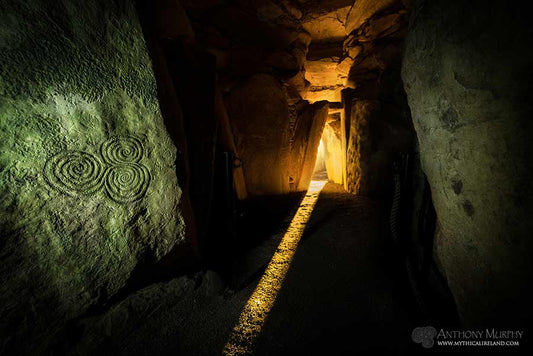
Fantastic new details emerge of monuments discovered near Newgrange during 2018 drought
On the day of winter solstice, when hundreds of people will gather at the 5,000-year-old chambered cairn of Newgrange (Síd in Broga) in the Boyne Valley to celebrate the ancient turning of the year, fascinating new insights are being revealed about monuments discovered during the summer drought of 2018.
The National Monuments Service has just revealed startling new details of a series of prehistoric monuments and structures discovered during an aerial imaging survey carried out near Newgrange during the summer, following the discovery by Anthony Murphy and Ken Williams of a previously unrecorded henge monument.
A comprehensive 138-page report details 22 monuments in the UNESCO World Heritage Site in the bend of the Boyne which were previously unknown or only partly described.

“The catalyst for the reconnaissance sorties,” says the report, “was the discovery in July of a large, complex henge monument manifesting itself as a series of cropmarks in a wheat field just south of Newgrange Farm. This discovery was made by Anthony Murphy and Ken Williams using drone technology and its unique pattern attracted the attention of the public and media across the world.”
In follow-up aerial reconnaissance, the National Monuments Service made several further discoveries. One is another henge, what they call the “Hidden Henge”, which is located between the henge found by Murphy and Williams and another site, LP2, previously discovered by the INSTAR project in 2010.

Another very exciting revelation is the fact that the triple palisade seen in the Williams and Murphy drone images, is part of a much greater monument.
“The section featured here is only a small portion of what appears to be a massive construction that might have divided separate ritual zones within the floodplain. Large palisade enclosures are known at other locations but none appear to emulate the complexity and scale of this new example from Newgrange,” the report states.

“Given the nature of the arc that is formed, and without knowing its exact course, this triple palisade could describe an enclosure c.900m across and would be analogous with palisade enclosures discovered in Britain, where they are closely associated with henge monuments.”
The henge discovered by Murphy and Williams is given particular attention, and several features within its interior are also described.

The adjacent “Hidden Henge” represents a great piece of detective work by the National Monuments Service archaeologists. They must have pored over the aerial images (many of which had to be specially enhanced to bring out the features) for many hours and days.
Anthony Murphy said: “This is tremendously exciting. This new report details 22 archaeological monuments and features that were either previously unknown or only partially recorded.”
“Our discovery on the evening of July 10th this year, of a henge monument and other features in the vicinity of Newgrange, and the publicity around those discoveries, led directly to the aerial survey by the National Monuments Service in the following days,” he added.

“What we're now seeing is a rewriting of the history of Brú na Bóinne and a redrawing of the maps. It's much more complex and diverse than anyone could have imagined. And there must have been a huge population involved in the construction of these enormous structures.”
“The archaeologists are now carefully and meticulously examining the aerial photography to reveal an extraordinary group of diverse monuments and features, the purpose and use of which will undoubtedly be the subject of scholarly debate and research for decades to come.”

“To be at the centre of these amazing discoveries is a great honour, and a tremendous personal reward for 20 years of researching the wonderful monuments and myths of the Boyne Valley.”
Read more about the discovery of the new henge of Newgrange here.
For a preliminary investigation of a possible astronomical orientation of the henge, see this page.

To see footage shot from Anthony Murphy's drone showing the new henge (referred to as the Geometric Henge in the report) taken during the week it was discovered, have a look at this YouTube video:
To read the Minister for Culture, Heritage and the Gaeltacht's statement about the new report, see this page.
Minister Josepha Madigan said: "This new information is a graphic illustration of the extent and density of ritual and ceremonial sites associated with the Newgrange Passage Tomb. As we celebrate this week the phenomenon of the winter solstice sunrise illuminating the burial chamber of the passage tomb at Newgrange, this stunning new archaeological information provides fresh, spectacular and unique insights into the origins and development of the Neolithic landscape and society.”

The Minister continued: "The new information reinforces the remarkable level of ceremonial and ritual use of the landscape around Newgrange during the prehistoric period up to 5,000 years. Immense enclosures of timber uprights and large ceremonial henges have been identified on the floodplain in the shadow of Newgrange passage tomb. These monuments, visible only fleetingly as cropmarks during the dry summer, clearly form a deliberately structured and ritual landscape of great significance."
Great Palisade size
Our friends at the Brú na Bóinne Visitor Centre for Newgrange and Knowth have done some calculations about the size of the Great Palisade.
If the palisade around Newgrange was about 900m in diameter, its circumference was about 3,000m and the area enclosed by it was about 65 hectares (160 acres). That is the equivalent of 2,560 tennis courts,160 American football fields and would make the Great Palisade at Newgrange about one-and-a-half times as big as the Vatican City. WOW!









